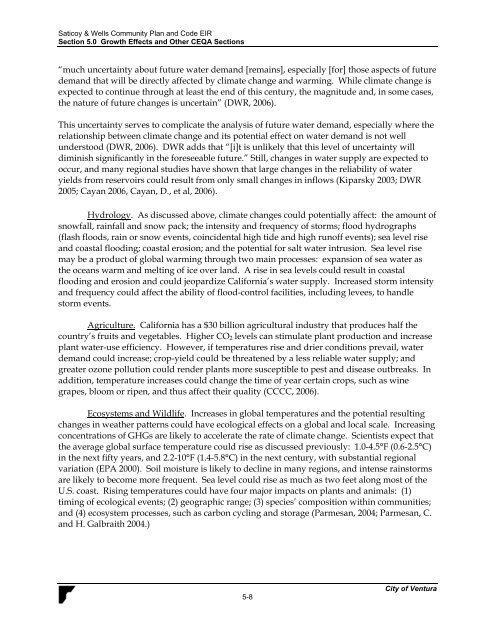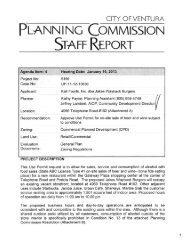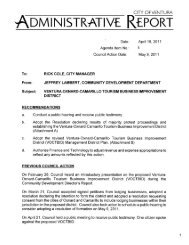Saticoy & Wells Community Plan & Development ... - City Of Ventura
Saticoy & Wells Community Plan & Development ... - City Of Ventura
Saticoy & Wells Community Plan & Development ... - City Of Ventura
Create successful ePaper yourself
Turn your PDF publications into a flip-book with our unique Google optimized e-Paper software.
<strong>Saticoy</strong> & <strong>Wells</strong> <strong>Community</strong> <strong>Plan</strong> and Code EIRSection 5.0 Growth Effects and Other CEQA Sections“much uncertainty about future water demand [remains], especially [for] those aspects of futuredemand that will be directly affected by climate change and warming. While climate change isexpected to continue through at least the end of this century, the magnitude and, in some cases,the nature of future changes is uncertain” (DWR, 2006).This uncertainty serves to complicate the analysis of future water demand, especially where therelationship between climate change and its potential effect on water demand is not wellunderstood (DWR, 2006). DWR adds that “[i]t is unlikely that this level of uncertainty willdiminish significantly in the foreseeable future.” Still, changes in water supply are expected tooccur, and many regional studies have shown that large changes in the reliability of wateryields from reservoirs could result from only small changes in inflows (Kiparsky 2003; DWR2005; Cayan 2006, Cayan, D., et al, 2006).Hydrology. As discussed above, climate changes could potentially affect: the amount ofsnowfall, rainfall and snow pack; the intensity and frequency of storms; flood hydrographs(flash floods, rain or snow events, coincidental high tide and high runoff events); sea level riseand coastal flooding; coastal erosion; and the potential for salt water intrusion. Sea level risemay be a product of global warming through two main processes: expansion of sea water asthe oceans warm and melting of ice over land. A rise in sea levels could result in coastalflooding and erosion and could jeopardize California’s water supply. Increased storm intensityand frequency could affect the ability of flood-control facilities, including levees, to handlestorm events.Agriculture. California has a $30 billion agricultural industry that produces half thecountry’s fruits and vegetables. Higher CO 2 levels can stimulate plant production and increaseplant water-use efficiency. However, if temperatures rise and drier conditions prevail, waterdemand could increase; crop-yield could be threatened by a less reliable water supply; andgreater ozone pollution could render plants more susceptible to pest and disease outbreaks. Inaddition, temperature increases could change the time of year certain crops, such as winegrapes, bloom or ripen, and thus affect their quality (CCCC, 2006).Ecosystems and Wildlife. Increases in global temperatures and the potential resultingchanges in weather patterns could have ecological effects on a global and local scale. Increasingconcentrations of GHGs are likely to accelerate the rate of climate change. Scientists expect thatthe average global surface temperature could rise as discussed previously: 1.0-4.5°F (0.6-2.5°C)in the next fifty years, and 2.2-10°F (1.4-5.8°C) in the next century, with substantial regionalvariation (EPA 2000). Soil moisture is likely to decline in many regions, and intense rainstormsare likely to become more frequent. Sea level could rise as much as two feet along most of theU.S. coast. Rising temperatures could have four major impacts on plants and animals: (1)timing of ecological events; (2) geographic range; (3) species’ composition within communities;and (4) ecosystem processes, such as carbon cycling and storage (Parmesan, 2004; Parmesan, C.and H. Galbraith 2004.)5-8<strong>City</strong> of <strong>Ventura</strong>
















